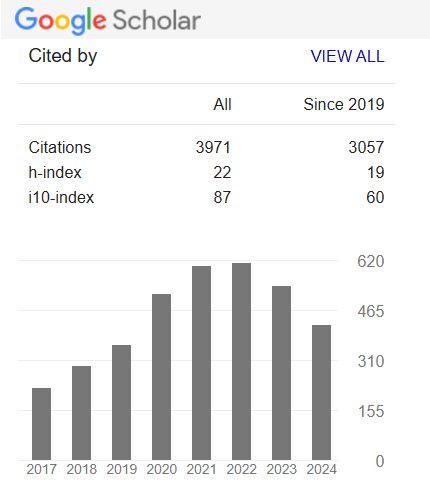Chemical composition of scent secretion from the dorsal abdominal scent glands in nymph of Coridius janus (Fabr.)
Keywords:
Coridius janus, larvae, abdominal scent glands, GC-MS, scent secretionsAbstract
Insects of many varieties have developed various modes of chemical and behavioral defensive mechanisms. When disturbed, many hemipterans release a pungent and volatile fluid with an offensive odour. These secretions may be used by the bugs as defensive substances. In the present investigation, identification of scent secretions of Coridius janus (Fabr.) and chemical composition of the scent secretion of larval abdominal scent glands. Coridius janus possesses abdominal scent glands in larvae. The extraction of scent secretion from larvae of Coridius janus was collected with the help of micro capillaries and subjected to analysis by Gas chromatographic and Mass spectra (GC-MS) and compared with authentic samples. The scent components from the larvae showed a seven peaks, in which six compounds are identified consisting of 5-iso-propenyl pentyl amine, 1- dodecane, n-tridecane, Indole-3-acetic acid ethyl ester, N-methyl-dodec-6,10-diene-amine and 6,10-dodec-dienyl acetate, remaining one peak is not identified.
Downloads
References
Ahmad, L and Syed Fafaqat Ali Kazmi (1976) A new species of the genus Dorpius Distant, 1900 from Sind, Pakistan, with a note on its Zoogeography and Phylogeny (Pentatomidae: Dorpini). MUSHI.49 (6) :63-71.
Aldrich JR (1988) Chemical ecology of the Heteroptera.Ann. Rev. Entomol. 33: 211-238.
Aldrich JR, Blum MS and Duffey SS (1976) Male specific natural products in he bug, Leptoglossusphyllops: Chemistry and possible function. J.Insect Physiol. 22: 1201-1206.
Aldrich JR, Kochansky JP, Lushy WR and Dotky SR (1982) Volatile male specific natural products of coreoid bug (Pachylislaticormis) (Hemiptera : Heteroptera) J. Chem. Ecol. 8 (11): 1369-1376.
Aldrich JR, Lusny WR, Kochansky JP and Abrams CB (1984) Volatile compounds from the predatory Insect, Podisusmaculiv entries (Hemiptera: Heteroptera: Pentatomidae) male and female dorosal abdominal gland secretion. J. Chem. Ecol. 10 (14) : 561 – 568.
Aldrich JR, Yonke TR and Oetting RD (1972) Histology and morphology of abdominal scent apparatus in three Alydids. J. Kan. Entomol. Soc. 45: 162-171.
Baggini A, Barnardi R, Casnati G, Pavan M and Rice A (1966) Ricerche Sulle Secrezioni defensive di insetti Emitteri Eterotterri (Hem.Heteroptera). Eas (Madrid), 42: 7-26.
Baldwin WF, Knight AG and Lynn KR (1971) A sex pheromone in the insect Rhodniusprolixus (Hemiptera :Reduviidae). Can. Entomol.103: 18.
Blum MS (1985) Alarm pheromones in comprehensive insect physiology, Biochemistry and Pharmacology, Vol. 9, ed. G.A. Kerkut, L.I. Gilbert, Oxford: Pergamon, 193-224.
Blum MS, Traynhan JC, Chidester JB and Boggus JD (1960) n- tridecane and trans-2iheptanal in scent gland fo the rick stink bug. Osbeluspugnax (F). Science. 132: 1480-1481.
Bowers MS, Nault LR, Webb RE, Dutky SR (1972) Aphid alarm pheromone: isolation identification, synthesis. Science, 177 (4054): 1121-1122.
Brindley MDH (1933) The development of thoracic stink glands of Heteroptera. Proc. Roy. Ent. Soc. 8: 1-2.
Brown KS, Jun (1975) The chemistry of aphids and scale insects. Chem. Soc. Rev., 4 (2): 263-288.
Butenandt A and Tam ND (1957) Uber Einen Geschlechtsspezi fischen Duffstoff der Wasserwanze Belostomaindiavita (Lethocerus indicus Lep.) Hoppeselyleros. Z. Physiol. Chem. 308: 277-283.
Butler CG (1967) Insect pheromone Biol. Rev. Cambridge Phil. Soc. 42: 42-87.
Calam DH and Youdeowei A (1968) Identification and functions of secretion from the posterior scent gland of fifth instar larvae of the bug. Dysdercusintermedius, J.Insect Physiol. 14: 1147-1158.
Dhiman SC (1985) Metathoracic odoriferous glands of Cletus signatus Walk. HeteropteraCoreidae. Uttar Prades J. Zool. 5(1): 79-81.
Dixon AFG (1958) The protective function of the siphunculi of the nettle aphid, Microlophiumevansi (Theob.) (Hem., Aphididae). Entomol.Man.Mag.,94: 8.
Eisner T and Meinwald YC (1965) Defensive secretion of a caterpillar (Papilio). Science (Wash. D.C.) 150: 1733-1735.
Eisner T, Pliske TE, Ikeda DF, Owen Vazques L, Peraz H, Franclemound G and Mein Wald J (1970) Defensive mechanisms of arthropods. XXVII Osmeterial secretions of papilonid caterpillars (Barnonia, Papillio, Eurytides) ANN. Entomol. Soc. Am.634: 914-915
Games DE and Staddon BW (1973) Composition of scent from the larva of the milk weed bug, Oncopeltusfasciatua. J. Insect Physiol. 19: 1527-1532.
Gilby AR and Waterhouse DF (1965) The composition of the scent of the green vegetable bug. Nezaraviridula. Proc. Roy. Soc. Biol. Sci. 162(1986): 105-120.
Harris VE and Todd JW (1980) Male-mediated aggregation of male female and 5th instar sourthern green stink bugs and concomitant attraction of a tachind parasitoid, Trichopodapemipes. Entomol. Exp. 27: 117-126.
Ishiwatari T (1974) Studies on the scent of stink bugs (Hemiptera: Pentatomidae). I. Alarm Pheromone activity. Appl. Entomol. Zool. 11(1): 38-44.
Jackson L (1983) Cuticular hydrocarbons of the milk weed bug. Oncepeltusfasciatus by age and sex. Insect Biochem. 13(1): 19-25.
Janaiah C (1978) Studies on the scent glands of two pentatomid bugs. Ph. D thesis Kakatiya University, Warangal.
Janaiah C, Chari N and Venkat Reddy P (1979) Glycogfen and total proteins in flight muscles and lateral scent glands of Tessaratomajavanica Thungerg (Pentatomidae: Hsemiptera). Entomon.4 (1): 65-66.
Janaiah C, LeelaKumari SJ, Rao PS and Surender P (1988) Chemical analysis of secretion from the abdominal scent glands of Chrysocorispurpureus (Heteroptera: pentatomidae). Proc. Indian Acad. Sci. (Ani. Sci. 97 (1):111-115.
Kislow CJ and Edwards LJ (1972) Repellent odour in aphids. Nature, 235 (5333): 10–109.
Leela Kumari SJ (1985) Histomorphology and chemical composition of scent glands of two heteropteran bugs (Fam. Pentatomidae). Ph.D. Thesis, Kakatiya University, Warangal.
LeelaKumari SJ and Janaiah C (1985) Histomorphology and chemical constituents of methathoracic scent glands of a bug, Tessaratomajavanica. Proc. 6th Nat Symp. Life Sci. 47-51.
Levinson HS, Levinson AR and Maschwitz U (1974 b) Action and composition of the alarm pheromone of the bed bug, CimexlectulariusL.NaturWissenschaften, Heft. 12: 684-685.
Levinson HZ and Barilan AR (1971) Assembling and alterting scent produced by the bed bug, Cimexlectularius. Experientia, 27: 102-103.
Lindsay KL (1969) Cornicles of the pea aphid, Acyrthosiphonpisum; their structure and function.A light and electron micro scrope study.Ann. Entol. Soc. Am., 62 (5): 1015-1021.
Meinwald J, Smolanoff J, Chibnall AC, Eisner T (1975) Characterizaion and synthesis of waxes from Homopterous.Insects. J. Chem. Ecol., I 1 (2)269-274.
Moody DL (1930) The morphology of the repugnatory glands of Anasatristis De Geer.Annals.Entomol. Soc. 23: 81-104.
Nault LR, Edwards LJ, Styer WE (1973) Aphid alarm pheromones: secretion and receiption. Environ. Entomol., 2 (1): 101-105.
Neelima Kumar and Kumar (1993) The stink gland cytoarchitecture and cytochemistry in the tree Bug Halysmagnus (Heteroptera: Pentatomidae). J. Anim. Morphol. Physiol., 40 (1&2): 169-173.
Pattenden G and Staddon BW (1968) Secretion of the metathoracic glands of the water bug, Notonectaglauca L. (Heteroptera: Notonectidae). Experientia.24: 1092.
Pattenden G and Staddon BW (1972) Identification of isobutyric acid in secretion from Brindley’s scent glands in Rhodniumprolixus (Heteroptera: Reduviidae). Ann. Entom. Soc. Ame. 65 (5): 1240-1241.
Puri LM (1924) Studies on the anatomy of C. lectulariusII.The stink organs. Parasitology.16: 268-278.
Remold H (1963) Scent glands of land bugs their physiology and biochemical function. Nature, 198: 764-768.
Schildnecht H, Winkler H and Maschwitz U(1968) Vergleichend chemische Untersuchungen der In halts stoffe der pygidialwehrblasen von carabiden. Z. Natur for Sch. 236: 637-644.
Schumacher R (1971 c) Zur funktionellen morphologie der imaginalen duff druisen zweier landwanzen 4 mitteilung: das ableitende kanalsystem and das reservoir des imaginales Duftdrusenkomplexes der Feuerwanze Phrrhocoris apterus L. (Geocorisae: Fam Pyrrhocoridae). Z. Wiss. Zool. 183 (1-2): 83-96.
Srinivasulu CH, Surender P and Janaiah C (1996) Chemical composition of scent from the abdominal scent glands of Halysdentatus.Bio.Science Research Bulletin. Vol. 12 (No.1) 15-22.
Stein G (1966 a) Uber denFeinban der duftdrusen von Feuerwanzen (Pyrrhocorisapterus L.) I Zur Funktionellen Morphologie der Druzenzelle, Z. ZellForsch. Mikrosk. Anant. 74: 271-290.
Surender P (1988) Chemical constituents of scent glands of heteropteran bugs and their application on other organisms. Ph.D. Thesis, Kakatiya University, Warangal.
Tsuquki T Ogata, Y Yamamoto I and Shimi K (1965) Stink bug aldehydes. Agr. Biol. Chem. 29 (5): 419-427.
Usinger RL (1938) Dorsal abdominal scent glands in nymphs of Lygaeidae. Pan. Pacif. Ent. 14 (2): 83.
Valcurone Dazzini M and Vita Finzi P (1974) Chemically known constituents of arthropod defensive secretions Ahi Accad. Naz. Lincei. Mem.Classa Sci. Fis Mat Nat (Sez.III), 12 (3): 107-146.
Vidyasagar CH (1995) Identification and functions of scent secretion from the scent glands of pentatomid bugs, Ph.D. Thesis, Kakatiya University, Warangal.
Waterhouse DF and Gilby AR (1964) The adult scent glands and scent of nine bugs of the super family coreoidae. J. Insect Physiol. 10: 977-987.
Waterhouse DF, Forss DA and Hackman RH (1961) Characteristic odour components in the secretion of stink bugs, J. Insect Physiol. 6: 113-121.
Wientjens WHJM, Lakwijk AC, Van Der Marel T (1973) Alarm pheromone of green aphids. Experientia. 29 (6): 658-660.
Wray J (1670) Some uncommon observations and experiments made with an acid juice to be found in ants. Phil Trans., 2063-2069.
Wynn GG, Boudreaux HB (1972) Structure and function of aphid cornicles. Ann. Entomol. Soc. Am., 65 (1): 157 – 166.
Youdeowei A and Calam DH (1969) The morphology of the scent glands of Dysdercusimtermedius Dist. (Hemiptera: Pyrrhocorridae) and a preliminary analysis of the scent gland secretion of the firth instar larvae. Proc. R.Ent. Soc. Long. (A). 44: 38-44.
Downloads
Published
How to Cite
Issue
Section
License
Copyright (c) 2024 Author

This work is licensed under a Creative Commons Attribution-NonCommercial-NoDerivatives 4.0 International License.
Open Access This article is licensed under a Creative Commons Attribution 4.0 International License, which permits use, sharing, adaptation, distribution and reproduction in any medium or format, as long as you give appropriate credit to the original author(s) and the source, provide a link to the Creative Commons license, and indicate if changes were made. The images or other third party material in this article are included in the article’s Creative Commons license unless indicated otherwise in a credit line to the material. If the material is not included in the article’s Creative Commons license and your intended use is not permitted by statutory regulation or exceeds the permitted use, you will need to obtain permission directly from the copyright holder. To view a copy of this license, visit http://creativecommons.org/ licenses/by/4.0/










